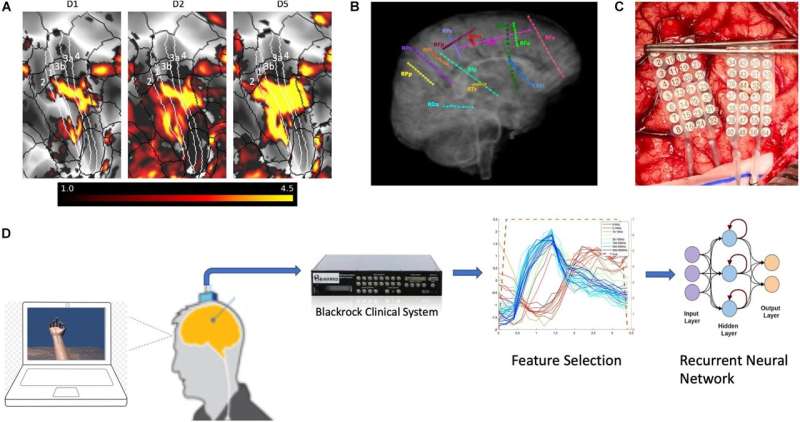Restoring proprioception and motor control in diabetes, injury and neuropathy patients

Tapping deep within the brain, a team of researchers from the Institute of Bioelectronic Medicine at The Feinstein Institutes for Medical Research has deciphered signals related to movement and touch. Study results were published today in Frontiers in Neuroscience in collaboration with Baylor College of Medicine and Washington University in St. Louis.
This first demonstration of decoding sulcal and subcortical activity will help researchers better understand how the brain processes tactile stimuli and manages hand motions. These findings and future studies may lead to new therapeutic methods to restore movement or sensation to those who may have lost it from injury, diabetes, or general neuropathy.
Three participants underwent minimally invasive surgery to implant stereoelectroencephalography (SEEG) electrodes deep within the brain—in sulcal and white matter areas—which has not been widely studied to decipher brain activity. The procedure was led by neurosurgeon, associate professor in the Institute of Bioelectronic Medicine and co-principal investigator on the study, Ashesh Mehta, MD. Researchers asked the participants to perform tasks with their hands through a brain-computer interface (BCI) link. By identifying and extracting repeating neural signals, the researchers were able to reliably and accurately predict finger movement and tactile stimuli in the pads of different fingers.
"Whether from diabetes or a traumatic injury, millions of people are living without something many of us take for granted—the sense of touch," said Chad Bouton, professor in the Feinstein Institutes' Institute of Bioelectronic Medicine and co-principal investigator on the study. "By observing these signals hidden deep within the brain, we are one step closer to restoring that sensation through stimulation and advances in the field of bioelectronic medicine."
The Feinstein Institutes is the global scientific home of bioelectronic medicine, a field of research that combines molecular medicine, neuroscience and biomedical engineering to develop innovative therapies with the aim to treat diseases and conditions through targeted stimulation of nerves, including paralysis, arthritis, pulmonary hypertension and inflammatory bowel disease.
This study's findings support the hypothesis that SEEG electrodes can be an effective approach for neural decoding and use in brain-computer interface systems. This minimally invasive approach reduces risk and may become the preferred approach for many BCI applications to restore movement and sensation.
"Using bioelectronic medicine approaches, including neural mapping and brain stimulation, researchers better understand how the brain communicates with the rest of the body," said Kevin J. Tracey, MD, president and CEO of the Feinstein Institutes.
This research continues to build on Prof. Bouton and his collaborators' work in sensorimotor mapping and stimulation. Most recently, his team published results in the journal Brain Stimulation, showing for the first time that highly focal fingertip sensations can be elicited through an SEEG brain implant.
More information: Chad Bouton et al, Decoding Neural Activity in Sulcal and White Matter Areas of the Brain to Accurately Predict Individual Finger Movement and Tactile Stimuli of the Human Hand, Frontiers in Neuroscience (2021). DOI: 10.3389/fnins.2021.699631


















